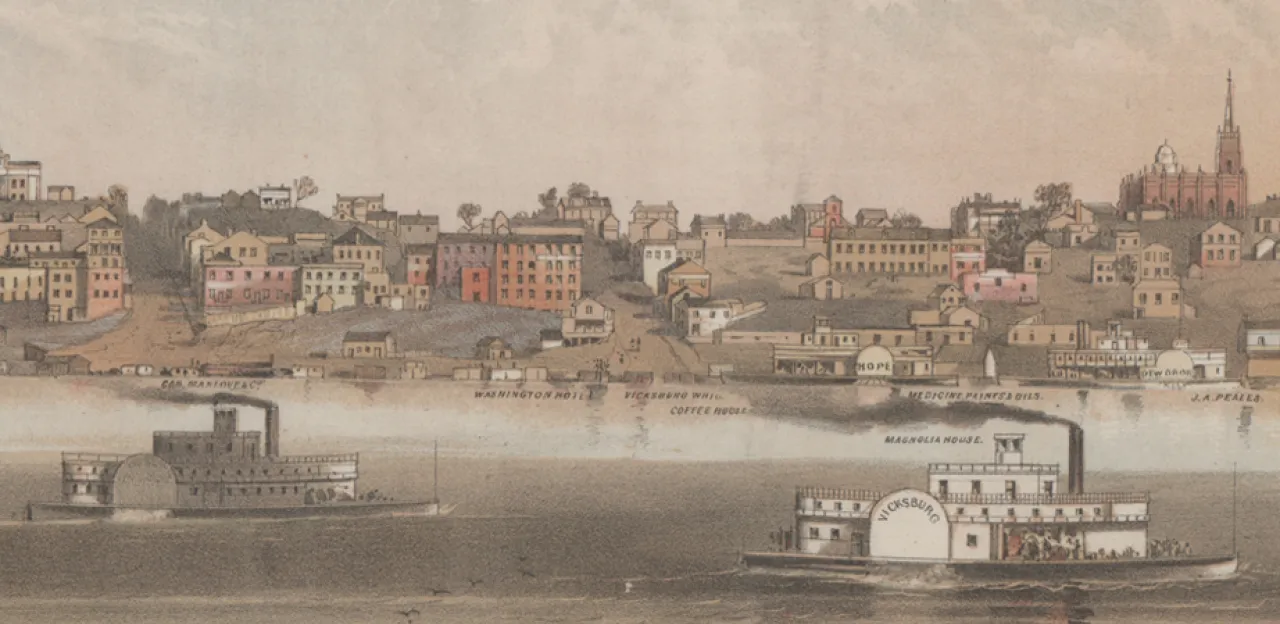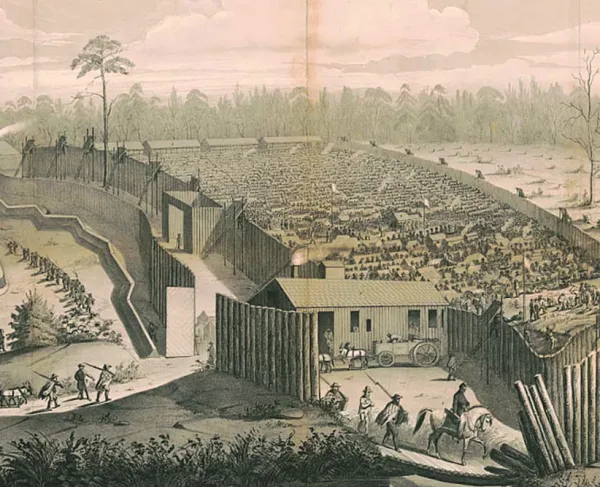“No Ingress or Egress”: Refugees of the Siege of Vicksburg
The Siege of Vicksburg was the culminating point of nearly a year’s worth of campaigning by the Federal Army to gain complete control over the Mississippi River. Lasting for 47 days from May 18 to July 4, 1863, the important city of Vicksburg, Mississippi, with both its garrison under Lt. Gen. John C. Pemberton and its civilian population were surrounded on land by Maj. Gen. Ulysses S. Grant’s army and on water by US Navy gunboats. Before the city was completely besieged, many civilians including men, women, children, and the enslaved tried to escape but were forced to return after encountering Pemberton’s troops. As a result, the thousands of civilians left in the city were forced to endure weeks of terror and uncertainty as they were bombarded. Unable to flee, civilians along with nearly 30,000 Confederate soldiers faced shortages of food, water, medicine, and comforts.
In the days leading up to the siege as Confederate forces were retreating into Vicksburg, civilians closely followed events including Emma Balfour, a diarist who lived next to Pemberton’s Headquarters. An observant diarist, Balfour wrote often of what she witnessed in Vicksburg. In one of her earliest entries written on May 17th, 1863, Mrs. Balfour wrote:
I hope never to witness again such a scene as the return of our routed army! From twelve o’clock until late in the night, the streets and roads were jammed with wagons, cannons, horses, men, mules, stock, sheep – everything you can imagine that appertains to an army being brought hurriedly within the entrenchment…
What is to become of all the living things in this place when the boats commence shelling, God only knows. Shut up as in a trap, no ingress or egress, are thousands of women and children, who have all fled here for safety. Then all the mules and horses belonging to this department – and all the stock of all kinds for fifteen or twenty miles around! The Dr. [her husband] thinks human life will be endangered by the stampede amongst these creatures when terror seizes them – for I fear we have not provender to feed them for long.
Emma Balfour was right. Soon shelling of the city began and finding food and water, as well as safe shelter, became a primary concern for those trapped inside. In order to gain protection from the constant shelling on the city and its surrounding forts, soldiers and refugees burrowed themselves into the ground creating caves to live in. The landscape of Vicksburg rising from the Mississippi River is a steep rise with firm soil making it easy to dig into the hillside without the fear of cave-ins, though escape tunnels sometimes connected families’ caves in case of a rare cave-in. A variety of refugee caves were built in Vicksburg from simple, one-room homes, to multiple room complexes with parlors and bedrooms. Occasionally connected with other families, some caves could be large enough to fit over sixty people. Valuables and furniture were moved from inside homes to the caves to give them the feel of home, but as much as they tried, the constant fear of shelling ensured it was not the same as a house.
One of the most comprehensive accounts of what it was like living in a cave during the siege comes from 26-year-old Mary Webster Loughborough who had only planned on visiting Vicksburg but got trapped in the city. Loughborough wrote of her experiences in My Cave Life in Vicksburg. In her “letters of trial and travel” she wrote not only of the building of the cave, but what it was like to live inside:
Our policy in building had been to face directly away from the river. All caves were prepared, as near as possible, in this manner. As the fragments of shells continued with the same impetus after the explosion, in but one direction, onward, they were not likely to reach us, fronting in this manner with their course…
…I went regularly to work, keeping house under ground. Our new habitation was an excavation made in the earth, and branching six feet from the entrance, forming a cave in the shape of a T. In one of the wings, my bed fitted; the other I used as a kind of a dressing room; in this the earth had been cut down a foot or two below the floor of the main cave; I could stand erect here; and when tired of sitting in other portions of my residence, I bowed myself into it, and stood impassively resting at full height—one of the variations in the still shell expectant life.
However, not everyone was able to get into a cave and had to find other shelter. One such person was diarist Dorra Miller:
June 9th. - The churches are a great resort for those who have no caves. People fancy that they are not shelled so much, and they are substantial and the pews good to sleep in. We had to leave this house last night, they were shelling our quarter so heavily. The night before, Martha forsook the cellar for a church. We went to H_’s office, which was comparatively quite last night. H_ carried the bank box; I the case of matches; Martha the blankets and pillows, keeping an eye on the shells. We slept on piles of old newspapers. In the streets the roar seems so much more confusing, I feel sure I shall run right in the way of a shell. They seem to have five different sounds from the second of throwing them to the hollow echo wandering among the hills, and that sounds the most blood-curdling of all.
No one was safe over the course of the siege. Homes were damaged and in Mrs. Balfour’s words, even if “most people live entirely in [the caves], for there is no safety anywhere else—indeed there is no safety there. Several accidents have occurred. In one cave, nearly a whole family was killed or crippled”. Lucy McRae, a young child at the time, was buried by dirt when a shell exploded above her cave.
A large mass of earth to slide from the side of the archway in a solid piece, catching me under it. Dr. Lord, whose leg was caught and held by it, gave the alarm that a child was buried. Mother reached me first, and a Mrs. Stites, who was partially paralyzed, with the assistance that Dr. Lord, who was in agony, could give, succeeded in getting my head out first. The people had become frightened, rushing into the street screaming, and thinking that the cave was falling in. Just as they reached the street over came another shell bursting just above them, and they rushed into the cave again. Then came my release. Mother had cried in distressing tones for help, so as soon as the men could get to me they pulled me from under the mass of earth. The blood was gushing from my nose, eyes, ears and mouth. A physician who was then in the cave was called, and said there were no bones broken, but he could not then tell what my internal injuries were…
Additionally, the enslaved of many refugees within the city were in even more danger for they were the ones who were sent outside the safety of the caves to complete necessary tasks such as getting food, cooking, and more.
One afternoon, amid the rush and explosion of the shells, cries and screams arose—the screams of women amid the shrieks of falling shells. The servant boy, George, after starting and coming back once or twice, his timidity overcoming his curiosity, at last gathered courage to go to the ravine near us, from whence the cried proceeded, and found that a negro man had been buried alive within a cave, he being alone at the time. Workmen were instantly set to deliver him if possible; but when found the unfortunate man had evidently been dead some little time. His wife and relations were distressed beyond measure, and filled the air with their cries and groans…
Food was a critical concern for the thousands of civilians within the city while it was besieged. Competing against tens of thousands of soldiers confined within the city, food, and water quickly became scarce:
Some families had light bread made in large quantities and subsisted on it with milk (provided their cows were not killed from one milking time to another), without any more cooking, until called on to replenish. Those most of us lived on corn bread and bacon, served three times a day, the only luxury of the meal consisting in its warmth, I had some flour, and frequently some hard, tough biscuit made from it, there being no soda or yeast to be procured. At this time, we could, also, procure beef.
Dorra Miller had a similar experience as early as May 28th as recounted in her diary:
I am so tired of corn-bread, which I never liked, which I eat it with tears in my eyes. We are lucky to get a quart of milk daily from a family near who have a cow they hourly expect to be killed. I send five dollars to market each morning, and it buys a small piece of mule-meat. Rice and milk is my main food; I can’t eat the mule-meat. We boil the rice and eat it cold with milk for supper. Martha runs the gauntlet to buy the meat and milk once a day in a perfect terror.
By July 3rd, Martha is still making daily runs to the market for Miller, but the food available changed, writing in her diary that Martha “says rats are hanging dressed in the market sale with mule meat - there is nothing else. It was said that when the rats were properly fried, they tasted like squirrel.”.
Independence Day proved to be a bittersweet holiday for the citizens of Vicksburg when the siege ended on July 4th, 1863. Pemberton surrendered to Grant and thousands of Union soldiers moved in to occupy the city. Mary Loughborough remembered the day vividly in her diary:
I felt a strange unrest, the quiet of the day was so unnatural. I walked up and down the cave until M----- returned. The day was extremely warm; and he came with a violent headache. He told me that the Federal troops had acted splendidly; they were stationed opposite the place where the Confederate troops marched up and stacked their arms; and they seemed to feel sorry for the poor fellows who had defended the place for so long a time…
…After the surrender, the old gray0headed soldier, in passing on the hill near the cave, stopped, and touching his had said: “It’s a sad day this, madam; I little thought we’d come to it, when we first stopped in the trenchments. I hope you’ll yet be happy, madam, after all the trouble you’ve seen”. To which I mentally responded, “Amen.”
As noncombatants emerged from their caves, malnourished and exhausted, they displayed a wide array of emotions. Enslaved African Americans found emancipation from slavery after the city fell to the US Army. Many white residents remained defiant in the occupation. Margaret Lord, a wife to a local minister serving in a Mississippi regiment in the Confederate army, refused aid from a Union Soldier offering to help her find food for her family. Another family stopped going to church because “the yankees have taken the Sunday School in their own hands”. Many Vicksburg residents remained defiant of the occupation forcing General McPherson to issue General Order No. 52 on December 27th decreeing “that any individual who insulted or showed disrespect for the president, government, or flag of the United States or toward any officer or soldier who be subject to fine, imprisonment, or banishment”.
The Civil War was a total war impacting everyone: men, women, and children, free and enslaved, soldiers and civilians. All throughout the South families lost their homes, found their property destroyed or stolen, or struggled to find food and shelter. During the siege of Vicksburg this happened suddenly, to an extreme within two months, causing bitterness and resentment that permeated generations for years following the end of the war.
Further Reading:
- The Women's Fight: The Civil War Battles for Home, Freedom, and Nation By: Thavolia Glymph
- Vicksburg: Grant's Campaign That Broke the Confederacy By: Donald L. Miller
- The Siege of Vicksburg: Climax of the Campaign to Open the Mississippi River, May 23-July 4, 1863 By: Timothy B. Smith
Related Battles
4,910
32,363







